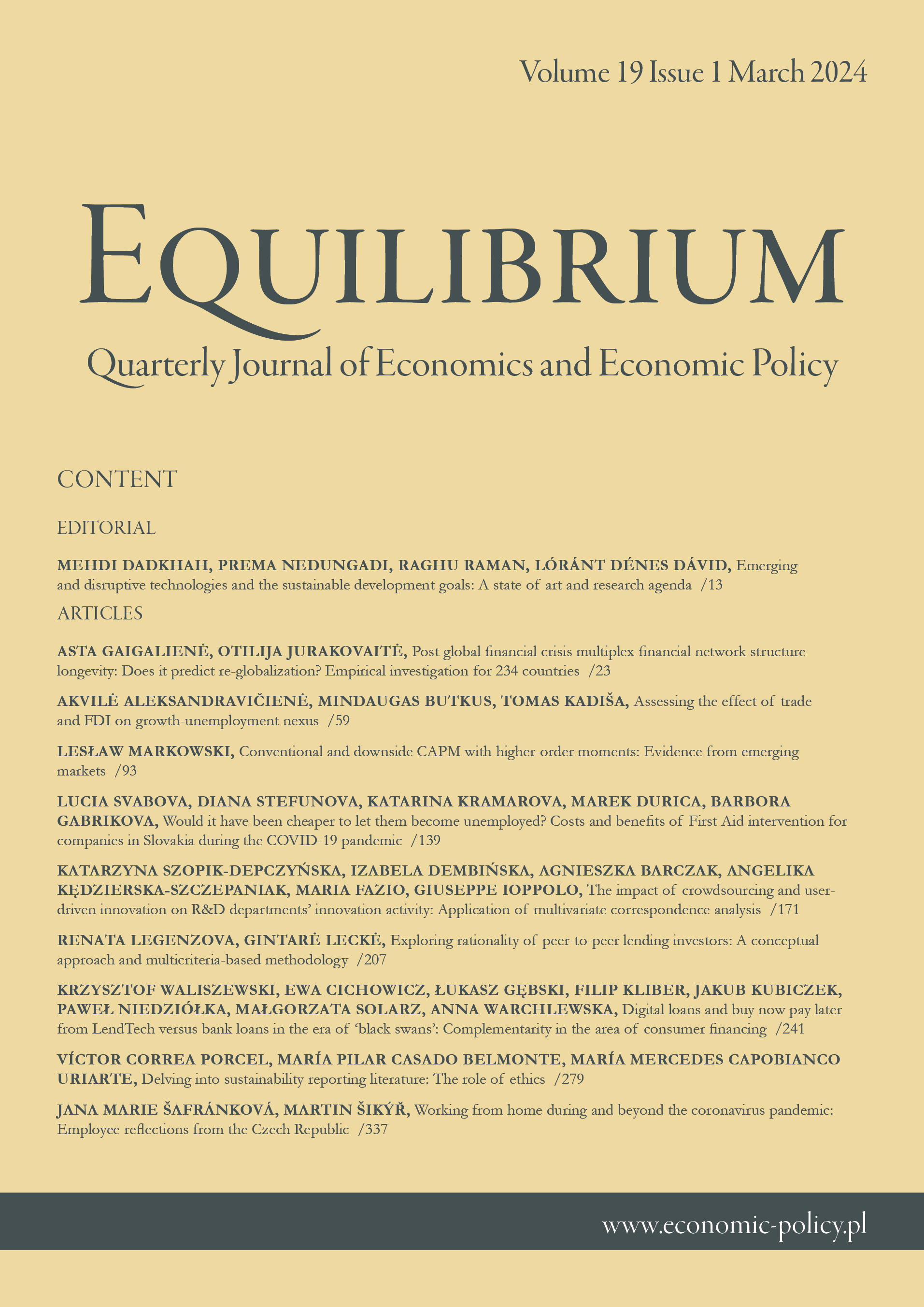Integration in Central European capital markets in the context of the global COVID-19 pandemic
IF 5
Q1 ECONOMICS
Equilibrium-Quarterly Journal of Economics and Economic Policy
Pub Date : 2020-12-20
DOI:10.24136/EQ.2020.027
引用次数: 47
Abstract
Research background: Covid-19 pandemic had a strong impact on the economy and capital market In times of crisis, it is important for investors to be able to diversify their investment portfolio in order to mitigate risk However, the growing trend towards capital market integration may make it ineffective Research on financial integration, during the Covid-19 period, has start10 24136/eq 2020 027 ed to develop, mainly in major global capital markets It is, therefore, important to extend this research to other capital markets The purpose of the article: This contribution aims to analyze financial integration in the stock indexes of the capital markets of Austria (ATX), Slovenia (SBITOP), Hungary (BUDAPEST SE), Lithuania (OMX VILNIUS), Poland (WIG), the Czech Republic (PX PRAGUE), Russia (MOEX) and Serbia (BELEX 15), in the context of the global pandemic (COVID-19) Methods: To measure the unit roots in the time series, we used ADF, PP, and KPSS tests, and Clemente et al (1998) test to detect structural breaks To ana-lyse financial integration, we applied the Gregory and Hansen integration test, and to validate the robustness of results, we use the impulse-response function (IRF) methodology, with Monte Carlo simulations, as they provide a dynamic analysis generated from the VAR model estimates Findings & Value added: The results suggest very significant levels of integration, which decreases the chances of portfolio diversification in the long-term Evidence shows 47 pairs of integrated stock market indexes (out of 56 possible) The stock indexes ATX, BUDAPESTE SE, BELEX 15 show financial integration with all other indexes On the contrary, the index of OMX VILNIUS shows only 3 integrations Results also show that most of the significant structural breaks occurred in March 2020 The analysis of the relationship between markets, in the short term, shows positive/negative co-movements, with statis-tical significance and with a persistence longer than one weekCOVID-19全球大流行背景下的中欧资本市场一体化
研究背景:Covid-19大流行对经济和资本市场产生了强烈影响。在危机时期,投资者能够分散投资组合以降低风险是很重要的。然而,资本市场一体化的趋势日益增长,可能会使其无效。本文的目的:本文旨在分析在全球大流行(COVID-19)的背景下,奥地利(ATX)、斯洛文尼亚(SBITOP)、匈牙利(BUDAPEST SE)、立陶宛(OMX VILNIUS)、波兰(WIG)、捷克共和国(PX PRAGUE)、俄罗斯(MOEX)和塞尔维亚(BELEX 15)资本市场股票指数的金融整合。为了测量时间序列中的单位根,我们使用ADF、PP和KPSS检验,并使用Clemente et al(1998)检验来检测结构断裂。为了分析金融整合,我们使用Gregory和Hansen整合检验,为了验证结果的稳稳性,我们使用脉冲响应函数(IRF)方法,并使用蒙特卡罗模拟,因为它们提供了由VAR模型估计产生的动态分析。结果表明,整合水平非常显著,这降低了长期投资组合多样化的机会。证据显示,47对整合的股票市场指数(56个可能的),股票指数ATX, BUDAPESTE SE, BELEX 15显示与所有其他指数的财务整合。OMX VILNIUS指数仅显示3个整合结果还表明,大多数重大结构性突破发生在2020年3月。对市场之间关系的分析,在短期内显示出正/负的共同运动,具有统计意义,持续时间超过一周
本文章由计算机程序翻译,如有差异,请以英文原文为准。
求助全文
约1分钟内获得全文
求助全文
来源期刊
CiteScore
9.20
自引率
3.50%
发文量
28
审稿时长
36 weeks
期刊介绍:
Equilibrium. Quarterly Journal of Economics and Economic Policy is a scientific journal dedicated to economics, which is the result of close cooperation between the Instytut Badań Gospodarczych/Institute of Economic Research (Poland) and Polish Economic Society and leading European universities. The journal constitutes a platform for exchange of views of the scientific community, as well as reflects the current status and trends of world science and economy.
The journal especially welcome empirical articles making use of quantitative methods in: Macroeconomics and Monetary Economics, International Economics, Financial Economics and Banking, Public Economics, Business Economics, Labor and Demographic Economics, Economic Development, and Technological Change, and Growth.
Current most preferable topics and special issues:
The economics of artificial intelligence: business potentials and risks;
Digitalization and entrepreneurship in economics;
Sustainable socio-economic development, environmental and ecological economics;
Transition in the energy market (improving energy efficiency, alternative energy sources, renewable energy, energy security).

 求助内容:
求助内容: 应助结果提醒方式:
应助结果提醒方式:


